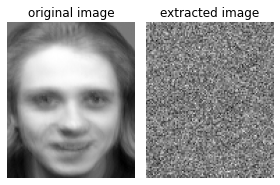8.2. MI-FACE vs DPSGD#
In Sec.2, we learned that machine learning model can leak the sensitive training data. One possible solution agianst these model inversion attacks is DPSGD, which makes the machine learning models less likely to leak confidential information.
Differentially Private Stochastic Gradient Descent (DPSGD) is a technique that combines the popular optimization algorithm, Stochastic Gradient Descent (SGD), with the privacy-preserving technique of differential privacy. The goal is to train machine learning models on sensitive data while ensuring that the information about any individual data point is not leaked during the training process.
The basic idea behind DPSGD is to add noise to the gradients calculated on the sensitive data before using them to update the model parameters. The noise is carefully chosen to ensure that the output of the model does not reveal any information about any specific data point, while still allowing the model to learn from the data.
DPSGD is a powerful technique for training machine learning models on sensitive data while ensuring privacy, but it is important to note that it can come with a trade-off in terms of model performance, as the added noise can make the optimization process less effective.
!git clone https://github.com/harveyslash/Facial-Similarity-with-Siamese-Networks-in-Pytorch.git
!mkdir data
!mv Facial-Similarity-with-Siamese-Networks-in-Pytorch/data/faces/testing/* data/
!mv Facial-Similarity-with-Siamese-Networks-in-Pytorch/data/faces/training/* data/
Cloning into 'Facial-Similarity-with-Siamese-Networks-in-Pytorch'...
remote: Enumerating objects: 550, done.
remote: Counting objects: 100% (18/18), done.
remote: Compressing objects: 100% (10/10), done.
remote: Total 550 (delta 6), reused 18 (delta 6), pack-reused 532
Receiving objects: 100% (550/550), 6.32 MiB | 28.91 MiB/s, done.
Resolving deltas: 100% (27/27), done.
import cv2
import numpy as np
import torch
import torch.nn as nn
import torch.nn.functional as F
import torch.optim as optim
import torchvision.transforms as transforms
from torch.utils.data import TensorDataset
from matplotlib import pyplot as plt
from sklearn.metrics import accuracy_score
import glob
from aijack.attack import MI_FACE
from aijack.defense import GeneralMomentAccountant, DPSGDManager
from aijack.utils import NumpyDataset
BASE = "data/"
class Net(nn.Module):
def __init__(self):
super(Net, self).__init__()
self.fla = nn.Flatten()
self.fc = nn.Linear(112 * 92, 40)
def forward(self, x):
x = self.fla(x)
x = self.fc(x)
x = F.softmax(x, dim=1)
return x
8.2.1. Setup#
imgs = []
labels = []
for i in range(1, 41):
for j in range(1, 11):
img = cv2.imread(BASE + f"s{i}/{j}.pgm", 0)
imgs.append(img)
labels.append(i - 1)
X = np.stack(imgs)
y = np.array(labels)
# ToTensor:画像のグレースケール化(RGBの0~255を0~1の範囲に正規化)、Normalize:Z値化(RGBの平均と標準偏差を0.5で決め打ちして正規化)
transform = transforms.Compose(
[transforms.ToTensor(), transforms.Normalize((0.5,), (0.5,))]
)
trainset = NumpyDataset(X, y, transform=transform)
trainloader = torch.utils.data.DataLoader(
trainset, batch_size=4, shuffle=True, num_workers=2
)
net = Net()
criterion = nn.CrossEntropyLoss()
optimizer = optim.SGD(net.parameters(), lr=0.005, momentum=0.9)
8.2.2. Training the target model#
lot_size = 40
batch_size = 1
iterations = 10
sigma = 0.5
l2_norm_clip = 1
delta = 1e-5
accountant = GeneralMomentAccountant(
noise_type="Gaussian",
search="ternary",
precision=0.001,
order_max=1,
order_min=72,
max_iterations=1000,
bound_type="rdp_upperbound_closedformula",
backend="python",
)
privacy_manager = DPSGDManager(
accountant,
optim.SGD,
l2_norm_clip=l2_norm_clip,
dataset=trainset,
lot_size=lot_size,
batch_size=batch_size,
iterations=iterations,
)
accountant.reset_step_info()
accountant.add_step_info(
{"sigma": sigma},
lot_size / len(trainset),
iterations * (len(trainset) / lot_size),
)
estimated_epsilon = accountant.get_epsilon(delta=delta)
print(f"estimated epsilon is {estimated_epsilon}")
accountant.reset_step_info()
dpoptimizer_cls, lot_loader, batch_loader = privacy_manager.privatize(
noise_multiplier=sigma
)
net = Net()
criterion = nn.CrossEntropyLoss()
optimizer = dpoptimizer_cls(net.parameters(), lr=0.05, momentum=0.9)
for epoch in range(iterations): # loop over the dataset multiple times
running_loss = 0
data_size = 0
preds = []
labels = []
for X_lot, y_lot in lot_loader(optimizer):
for X_batch, y_batch in batch_loader(TensorDataset(X_lot, y_lot)):
optimizer.zero_grad()
pred = net(X_batch)
loss = criterion(pred, y_batch.to(torch.int64))
loss.backward()
optimizer.step()
running_loss += loss.item()
data_size += X_batch.shape[0]
preds.append(pred)
labels.append(y_batch)
preds = torch.cat(preds)
labels = torch.cat(labels)
print(f"epoch {epoch}: loss is {running_loss/data_size}")
print(f"final epsilon is {accountant.get_epsilon(delta=delta)}")
estimated epsilon is 35.149970335258836
epoch 0: loss is 3.6771469538651624
epoch 1: loss is 3.6257011240178887
epoch 2: loss is 3.5296070947714733
epoch 3: loss is 3.393697807312012
epoch 4: loss is 3.280472491979599
epoch 5: loss is 3.194252625984304
epoch 6: loss is 3.0832332244834997
epoch 7: loss is 3.02003865778161
epoch 8: loss is 3.005151098572855
epoch 9: loss is 2.9427295653103607
final epsilon is 35.14997033525883
in_preds = []
in_label = []
with torch.no_grad():
for data in trainloader:
inputs, labels = data
outputs = net(inputs)
in_preds.append(outputs)
in_label.append(labels)
in_preds = torch.cat(in_preds)
in_label = torch.cat(in_label)
print(
"Test Accuracy is: ",
accuracy_score(np.array(torch.argmax(in_preds, axis=1)), np.array(in_label)),
)
Test Accuracy is: 0.9175
8.2.3. Attack#
input_shape = (1, 1, 112, 92)
target_label = 11
lam = 0.03
num_itr = 100
mi = MI_FACE(
net,
input_shape,
target_label=target_label,
num_itr=num_itr,
lam=lam,
log_interval=0,
)
x_result_1, log = mi.attack()
fig, axes = plt.subplots(nrows=1, ncols=2, figsize=(4, 3))
axes[0].imshow(
np.mean([cv2.imread(p, 0) for p in glob.glob(BASE + "s12/*.pgm")], axis=0),
cmap="gray",
)
axes[0].axis("off")
axes[0].set_title("original image")
axes[1].imshow(x_result_1[0][0].detach().numpy(), cmap="gray")
axes[1].axis("off")
axes[1].set_title("extracted image")
fig.tight_layout()
fig.show()

